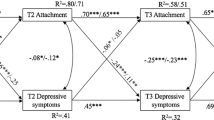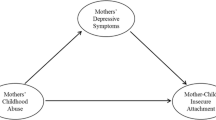Abstract
Early attachment quality may be a lasting source of vulnerability or protection in children’s development. In this study, we examine whether attachment quality at age three moderates the impact of subsequent exposure to maternal depression (at age five or nine) on children’s externalizing symptoms at age nine. The sample included 1,917 low-income families (mean child age = 9.28; 55.9% African-American, 20.6% White, 20.0% Latina, 3.5% Other) from the Fragile Families and Child Well Being Study. At age three, 23.9% of children were categorized as insecurely attached based on maternal report of their child’s attachment behaviors. At age nine, mothers, teachers, and children reported on the child’s externalizing behaviors. Mothers also completed measures of maternal depression at child age three, five, and nine. Controlling for age three externalizing (by maternal report) and age three maternal depression as well as various demographic factors, attachment quality interacted with exposure to subsequent maternal depression in predicting externalizing behaviors at age nine. Interaction effects were evident in mother, teacher, and child report of externalizing. Across all three reporters, exposure to maternal depression was associated with greater externalizing behaviors in children who exhibited insecure attachment behaviors at age three. These findings highlight the potential benefit of interventions to improve early parent–child relationships for families at elevated risk because of maternal mental health.

Similar content being viewed by others
Notes
A small percentage (about 5%) of children were scored high in security and dependency, and these children were categorized as insecure.
References
Achenbach, T. M., & Rescorla, L. A. (2001). Manual for the ASEBA School-Age Forms & Profiles: Burlington. VT: University of Vermont, Research Center for Children, Youth & Families.
Badovinac, S., Martin, J., Guérin-Marion, C., O'Neill, M., Riddell, R. P., Bureau, J., & Spiegel, R. (2018). Associations between mother-preschooler attachment and maternal depression symptoms: A systematic review and meta-analysis. Plos One, 13(10) doi:https://doi.org/10.1371/journal.pone.0204374
Belsky, J., & Fearon, R. M. P. (2002). Early attachment security, subsequent maternal sensitivity, and later child development: Does continuity in development depend upon continuity of caregiving? Attachment & Human Development, 4(3), 361–387. https://doi.org/10.1080/14616730210167267.
Brennan, P. A., Le Brocque, R., & Hammen, C. (2003). Maternal depression, parent-child relationships, and resilient outcomes in adolescence. Journal of the American Academy of Child & Adolescent Psychiatry, 40(5), 1469–1477. https://doi.org/10.1097/00004583-200312000-00014.
Brett, B. E., Stern, J. A., Gross, J. T., & Cassidy, J. (2020). Maternal depressive symptoms and preschoolers’ helping, sharing, and comforting: The moderating role of child attachment. Journal of Clinical Child & Adolescent Psychology. https://doi.org/10.1080/15374416.2020.1738235.
Cadman, T., Diamond, P. R., & Fearon, P. (2018). Reassessing the validity of the attachment Q‐sort: An updated meta‐analysis. Infant and Child Development, 27(1).
Cassidy, J., Brett, B., Gross, J., Stern, J., Martin, D., Mohr, J., et al. (2017). Circle of security-parenting: A randomized controlled trial in head start. Development and Psychopathology, 29, 651–673.
Chaplin, T. M., & Aldao, A. (2013). Gender differences in emotion expression in children: A meta-analytic review. Psychological Bulletin, 139(4), 735–765. https://doi.org/10.1037/a0030737.
Conners, C., Sitarenios, G., Parker, J., & Epstein, J. (1998). Revision and restandardization of the conners teacher rating scale (CTRS-R): Factor structure, reliability, and criterion validity. Journal of Abnormal Child Psychology, 26(4), 279–291.
Cummings, E. M., & Davies, P. T. (1994). Maternal depression and child development. Child Psychology & Psychiatry & Allied Disciplines, 35(1), 73–112. https://doi.org/10.1111/j.1469-7610.1994.tb01133.x.
Dodge, K. A., Bates, J. E., & Pettit, G. S. (1990). Mechanisms in the cycle of violence. Science, 250(4988), 1678–1683. https://doi.org/10.1126/science.2270481.
Downey, G., & Coyne, J. C. (1990). Children of depressed parents: An integrative review. Psychological Bulletin, 108(1), 50–76. https://doi.org/10.1037/0033-2909.108.1.50.
Fearon, R. P., Bakermans-Kranenburg, M., & van IJzendoorn, M. H., Lapsley, A., & Roisman, G. I. . (2010). The significance of insecure attachment and disorganization in the development of children s externalizing behavior: A meta-analytic study. Child Development, 81(2), 435–456.
Fearon, R.M.P., & Belsky, J. (2004). Attachment and Attention: Protection in Relation to Gender and Cumulative Social-Contextual Adversity. Child Development, 75(6), 1677–1693. https://doi-org.ezproxy.lib.uconn.edu/10.1111/j.1467-8624.2004.00809.x
Foster, C. J. E., Garber, J., & Durlak, J. A. (2008). Current and past maternal depression, maternal interaction behaviors, and children’s externalizing and internalizing symptoms. Journal of Abnormal Child Psychology, 36(4), 527–537. https://doi.org/10.1007/s10802-007-9197-1.
Gaylord-Harden, N., Taylor, J. J., Campbell, C. L., Kesselring, C. M., & Grant, K. E. (2009). Maternal attachment and depressive symptoms in urban adolescents: The influence of coping strategies and gender. Journal of Clinical Child & Adolescent Psychology, 38(5), 685–695. https://doi.org/10.1080/15374410903103569.
Goodman, S. H., & Gotlib, I. H. (2002). In Goodman S. H., Gotlib I. H.(Eds.), Transmission of risk to children of depressed parents: Integration and conclusions. Washington, DC: American Psychological Association. https://doi.org/10.1037/10449-012.
Goodman, S. H., Rouse, M. H., Connell, A. M., Broth, M. R., Hall, C. M., & Heyward, D. (2011). Maternal depression and child psychopathology: A meta-analytic review. Clinical Child and Family Psychology Review, 14(1), 1–27. https://doi.org/10.1007/s10567-010-0080-1.
Greenberg, M. T., DeKlyen, M., Speltz, M. L., & Endriga, M. C. (1997). The role of attachment processes in externalizing psychopathology in young children. In L. Atkinson, & K. J. Zucker (Eds.), (pp. 196–222). New York, NY: Guilford Press.
Houston, J., & Grych, J. (2016). Maternal attachment buffers the association between exposure to violence and youth attitudes about aggression. Journal of Clinical Child & Adolescent Psychology, 45(5), 605–613. https://doi.org/10.1080/15374416.2014.987380.
Kessler, R., Andrews, G., Mroczek, D., Ustun, B., & Wittchen, H. (1998). The World Health Organization composite international diagnostic interview short-form (CIDI-SF). International Journal of Methods in Psychiatric Research, 7, 171–185.
Keyser, D., Ahn, H., & Unick, J. (2017). Predictors of behavioral problems in young children 3 to 9 years old: The role of maternal and child factors. Children and Youth Services Review, 82, 149–155. https://doi.org/10.1016/j.childyouth.2017.09.018.
Kim, S., Kochanska, G., Boldt, L. J., Nordling, J. K., & O’Bleness, J. J. (2014). Developmental trajectory from early responses to transgressions to future antisocial behavior: Evidence for the role of the parent–child relationship from two longitudinal studies. Development and Psychopathology, 26(1), 93–109.
Kirkland, J., Bimler, D., Drawneek, A., McKim, M., & Schölmerich, A. (2004). An alternative approach for the analyses and interpretation of attachment sort items. Early Child Development and Care, 174(7–8), 701–719. https://doi.org/10.1080/0300443042000187185.
Kraemer, H. C., Stice, E., Kazdin, A., Offord, D., & Kupfer, D. (2001). How do risk factors work together? mediators, moderators, and independent, overlapping, and proxy risk factors. The American Journal of Psychiatry, 158(6), 848–856. https://doi.org/10.1176/appi.ajp.158.6.848.
Lansford, J. E., Malone, P. S., Dodge, K. A., Crozier, J. C., Pettit, G. S., & Bates, J. E. (2006). A 12-year prospective study of patterns of social information processing problems and externalizing behaviors. Journal of Abnormal Child Psychology, 34(5), 715–724. https://doi.org/10.1007/s10802-006-9057-4.
Lieb, R., Isensee, B., Höfler, M., Pfister, H., & Wittchen, H. (2002). Parental major depression and the risk of depression and other mental disorders in offspring: A prospective-longitudinal community study American Medical Association. https://doi.org/10.1001/archpsyc.59.4.365.
Lovejoy, M. C., Graczyk, P. A., O’Hare, E., & Neuman, G. (2000). Maternal depression and parenting behavior: A meta-analytic review. Clinical Psychology Review, 20(5), 561–592. https://doi.org/10.1016/S0272-7358(98)00100-7.
Maumary-Gremaud, A. (2000). Things that you have done. (Technical Report) http://www.fasttrackproject.org/techrept/t/tyd/tyd5tech.pdf
Milan, S., Snow, S., & Belay, S. (2009). Depressive symptoms in mothers and children: Preschool attachment as a moderator of risk. Developmental Psychology, 45(4), 1019–1033. https://doi.org/10.1037/a0016164.
Moffitt, T., Caspi, A., Dickson, N., Silva, P., & Stanton, W. (1996). Childhood-onset versus adolescent-onset antisocial conduct problems in males: Natural history form ages 3 to 18 years. Development and Psychopathology, 8(2), 399–424. https://doi.org/10.1017/S0954579400007161.
Nakamura, B., Ebesutani, C., Bernstein, A., & Chorpita, B. (2009). A psychometric analysis of the child behavior checklist DSM-oriented scales. Journal of Psychopathology and Behavior Assessment, 31, 178–189.
Qi, C. H., & Kaiser, A. P. (2003). Behavior problems of preschool children from low-income families: Review of the literature. Topics in Early Childhood Special Education, 23(4), 188–216. https://doi.org/10.1177/02711214030230040201.
Ramos-Marcuse, F., & Arsenio, W. F. (2001). Young children’s emotionally-charged moral narratives: Relations with attachment and behavior problems. Early Education & Development, 12(2), 165–184.
Reichman, N., Teitler, J., Garfinkel, I., & McLanahan, S. (2001). Fragile families: Sample and design. Child and Youth Services Review, 23(4), 303–326.
Scaramella, L. V., & Leve, L. D. (2004). Clarifying parent-child reciprocities during early childhood: The early childhood coercion model. Clinical Child and Family Psychology Review, 7(2), 89–107. https://doi.org/10.1023/B:CCFP.0000030287.13160.a3.
Schechter, D. S., Willheim, E., Hinojosa, C., Scholfield-Kleinman, K., Turner, J. B., McCaw, J., et al. (2010). Subjective and objective measures of parent-child relationship dysfunction, child separation distress, and joint attention. Psychiatry, 73(2), 130–144. https://doi.org/10.1521/psyc.2010.73.2.130.
Schieche, M., & Spangler, G. (2005). Individual differences in biobehavioral organization during problem-solving in toddlers: The influence of maternal behavior, infant-mother attachment, and behavioral inhibition on the attachment-exploration balance. Developmental Psychobiology, 46(4), 293–306. https://doi.org/10.1002/dev.20065.
Shmueli-Goetz, Y., Target, M., Fonagy, P., & Datta, A. (2008). The child attachment interview: A psychometric study of reliability and discriminant validity. Developmental Psychology, 44(4), 939–956. https://doi.org/10.1037/0012-1649.44.4.939.
Sroufe, L. A., Carlson, E. A., Levy, A. K., & Egeland, B. (1999). Implications of attachment theory for developmental psychopathology. Development and Psychopathology, 11(1), 1–13.
Suchman, N. E., DeCoste, C. L., McMahon, T. J., Dalton, R., Mayes, L. C., & Borelli, J. (2017). Mothering from the inside out: Results of a second randomized clinical trial testing a mentalization-based intervention for mothers in addiction treatment. Development and Psychopathology, 29(2), 617–636. https://doi.org/10.1017/S0954579417000220.
Tharner, A., Luijk, M. P. C. M., & van IJzendoorn, M. H., Bakermans-Kranenburg, M., Jaddoe, V. W. V., Hofman, A., …Tiemeier, H. . (2012). Maternal lifetime history of depression and depressive symptoms in the prenatal and early postnatal period do not predict infant–mother attachment quality in a large, population-based dutch cohort study. Attachment & Human Development, 14(1), 63–81. https://doi.org/10.1080/14616734.2012.636659.
Tharner, A., Luijk, M. P. C. M., van IJzendoorn, M. H., Bakermans-Kranenburg, M., Jaddoe, V. W. V., Hofman, A., . . . Tiemeier, H. (2012b). Infant attachment, parenting stress, and child emotional and behavioral problems at age 3 years. Parenting: Science and Practice, 12(4), 261–281. https://doi.org/10.1080/15295192.2012.709150.
van Ijzendoorn, M. H., Vereijken, C. M. J. L., Bakermans-Kranenburg, M., & Riksen-Walraven, J. (2004). Assessing attachment security with the attachment Q sort: Meta-analytic evidence for the validity of the observer AQS. Child Development, 75(4), 1188–1213. https://doi.org/10.1111/j.1467-8624.2004.00733.x.
Villodas, M. T., Bagner, D. M., & Thompson, R. (2018). A step beyond maternal depression and child behavior problems: The role of mother–child aggression. Journal of Clinical Child and Adolescent Psychology, 47(4), 634–641. https://doi.org/10.1080/15374416.2015.1094740.
Walters, E.E., Kessler, R.C., Nelson, R.C., & Mroczek, D. (2002). Scoring the World Health Organization's Composite International Diagnostic Interview Short Form (CIDI-SF; Dec 2002).
Ward, K., Lee, S., Pace, G., Grogan-Kaylor, A., & Ma, J. (2019). Attachment style and the association of spanking and child externalizing behavior. Academic Pediatrics, 20(4), 1–7. https://doi.org/10.1016/j.acap.2019.06.017.
Waters, E. (1987). Attachment Q-set (Version 3) pp. 1–27. Retrieved from http://www.johnbowlby.com.
Waters, E., & Deane, K. E. (1985). Defining and assessing individual differences in attachment relationships: Q-methodology and the organization of behavior in infancy and early childhood. Monographs of the Society for Research in Child Development, 50(1–2), 41–65. https://doi.org/10.2307/3333826.
Woodhouse, S. S., Ramos-Marcuse, F., Ehrlich, K. B., Warner, S., & Cassidy, J. (2009). The role of adolescent attachment in moderating and mediating the links between parent and adolescent psychological symptoms. Journal of Clinical Child & Adolescent Psychology, 39(1), 51–63. https://doi.org/10.1080/15374410903401096.
Zahn-Waxler, C., Shirtcliff, E. A., & Marceau, K. (2008). Disorders of childhood and adolescence: Gender and psychopathology. Annual Review of Clinical Psychology, 4, 275–303. https://doi.org/10.1146/annurev.clinpsy.3.022806.091358.
Author information
Authors and Affiliations
Corresponding author
Ethics declarations
Conflict of Interest
The authors have no conflicts of interest to report.
Additional information
Publisher’s Note
Springer Nature remains neutral with regard to jurisdictional claims in published maps and institutional affiliations.
Supplementary Information
Below is the link to the electronic supplementary material.
10802_2020_747_MOESM1_ESM.docx
Supplementary file1: Supplemental Table 1: A breakdown of demographic characteristics by each attachment and exposure to subsequent maternal depression group (DOCX 18.9 kb)
Rights and permissions
About this article
Cite this article
Carlone, C., Milan, S. Maternal Depression and Child Externalizing Behaviors: The Role of Attachment Across Development in Low-income Families. Res Child Adolesc Psychopathol 49, 603–614 (2021). https://doi.org/10.1007/s10802-020-00747-z
Accepted:
Published:
Issue Date:
DOI: https://doi.org/10.1007/s10802-020-00747-z




